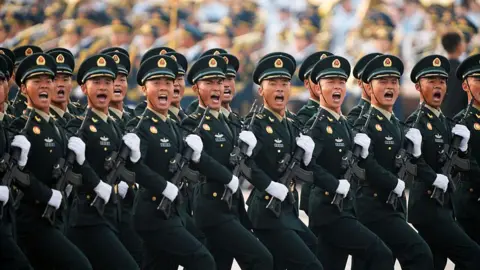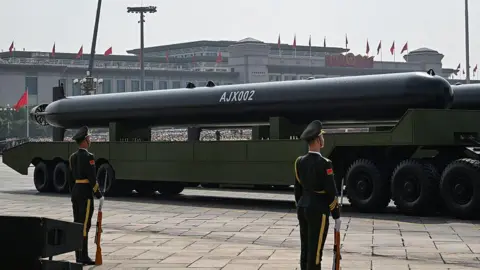Xi, Putin and Kim Appear Together as China Unveils New Weapons at Beijing Parade
Leaders of China, Russia and North Korea stood shoulder to shoulder at an 80th‑anniversary ceremony that showcased new Chinese military hardware and drew commentary from BBC correspondents about the message it sent internationally.
Chinese leader Xi Jinping, Russian President Vladimir Putin and North Korean leader Kim Jong Un stood publicly shoulder to shoulder on Wednesday as Beijing staged a large military parade marking the 80th anniversary of China’s victory over Japan in World War Two. The event showcased advanced military systems that Chinese officials presented as evidence of a modernising force and drew immediate commentary from BBC correspondents about the diplomatic and strategic message the spectacle sent.
The parade presented a range of weaponry that state media and analysts said included a new nuclear intercontinental ballistic missile, a road‑mobile missile intended to deliver hypersonic warheads, a directed‑energy laser system and several unmanned “robotic dog” ground drones. BBC correspondents, including China correspondent Laura Bicker, assessed the display as part of Xi’s effort to project Beijing’s power on the international stage and suggested it was intended to signal Beijing’s growing military capabilities to the United States and other powers.

State broadcasters described the march as a commemoration of the end of the Asia‑Pacific war in 1945 and as a demonstration of national resolve. Foreign policy analysts and correspondents noted the optics of the three leaders appearing together in public for the first time, saying the image amplified the diplomatic significance of the anniversary beyond domestic remembrance.
Chinese officials framed the event as both a tribute to wartime sacrifice and a showcase of technological progress made by the People’s Liberation Army. Military experts said several of the systems paraded reflected long‑term priorities for China’s defence modernisation, including survivable nuclear deterrents, high‑speed strike options and experimental directed‑energy and unmanned platforms.
BBC correspondents placed the parade in a wider geopolitical context. They said the timing and content of the display could be read as a message to the United States at a moment when bilateral tensions over trade and influence remain elevated. Some of the correspondents highlighted the role of recent US trade measures, describing the parade as signalling Beijing’s intent to present itself as a counterweight to US economic and strategic pressure.
Analysts cautioned that public parades are designed to achieve multiple audiences: domestic viewers, regional neighbours and distant powers. In Beijing, the ceremonial elements reinforced the Communist Party’s narrative of historical continuity and national rejuvenation. For foreign observers, the new platforms on show fed into debates about how quickly and in what ways China’s military posture is changing.
Experts emphasised that public displays alone do not fully reveal operational capabilities, which depend on testing, deployment, logistics and integration with command systems. Several weapons paraded were described by commentators as prototypes or variants of previously announced programmes; independent verification of performance claims typically requires open testing data that state displays do not provide.
The presence of Putin and Kim added a diplomatic dimension that commentators said amplified the parade’s message. Their attendance underscored bilateral ties that Beijing has sought to manage carefully amid competing relationships in the region and with Western powers. Diplomats and strategic analysts observed that such high‑profile appearances carry symbolic weight but do not by themselves define the full scope of military cooperation among the countries represented.
State and foreign media coverage underscored differing emphases: Chinese outlets focused on national unity and technological achievement, while international commentators parsed the strategic implications for deterrence, regional stability and great‑power rivalry. BBC correspondents concluded that the event was intended to serve multiple purposes simultaneously, reinforcing domestic legitimacy while signalling capability and intent to external audiences.
Reporting and commentary following the parade noted that demonstrations of new hardware are one element of long‑term military competition and diplomatic posturing. Observers said further assessments will depend on subsequent deployments, official statements about doctrine and verifiable evidence of the systems’ operational performance. Until then, analysts said, the parade will stand as a high‑visibility moment that combined commemoration with a carefully staged projection of power.
